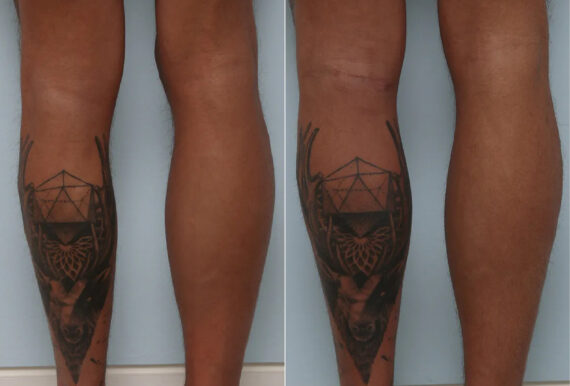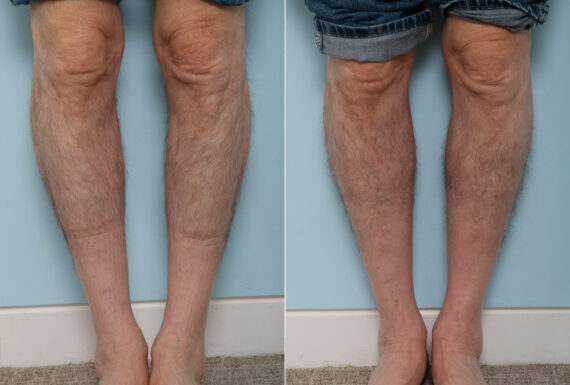Calf implants are a cosmetic surgery procedure that allows people to improve the look and feel of their lower legs. If having thin legs makes you uncomfortable, calf implants can help create a more proportionate look.
Dr. Paul Vitenas has a long track record in performing calf augmentation surgeries. He focuses on giving each patient care designed for their individual goals. His approach is to achieve results that look natural and make safety a top priority.

Improve the Look of Your Legs with Calf Implants
- Calf implants offer a solution for enhancing leg shape and size, especially for those with naturally skinny legs.
- The procedure involves inserting silicone implants into the calves to create a more balanced and muscular appearance.
- Recovery from calf implant surgery typically requires several weeks, with full activity resuming after about six months.
- Risks associated with calf implants include infection, implant displacement, and unsatisfactory cosmetic results.
- Consultation with a board-certified plastic surgeon is essential to determine if calf implants are appropriate for your body type and goals.
Calf Implants for Enhanced Leg Contours
Calf implants cater to those aiming to enhance the look of slim or underdeveloped calf muscles for cosmetic reasons. This procedure, beneficial for cosmetic and reconstructive purposes, improves leg shapes by creating fuller and more proportionate calves.
Individuals with muscle imbalance or calves resistant to exercise might consider calf augmentation surgery as an option to achieve a more defined look. Using solid silicone implants, tailored to the natural contours of the leg muscles, calf implants offer a noticeable change, aligning with one’s body image goals and addressing cosmetic concerns. This surgical approach can help individuals gain a consistent appearance over time and feel more confident about their lower legs.
Identifying the Right Candidates for Calf Implant Surgery
An ideal candidate for calf implants is someone seeking improved calf size and the appearance of toned calves. Those with underdeveloped calf muscles who find little success with exercise might consider this procedure, as well as bodybuilders aiming for a proportional look between their upper and lower body.
A personal consultation is crucial to determining if an individual is a suitable candidate for calf implants. During the consultation, surgeons assess the individual’s general health and leg structure and discuss desired outcomes to ensure that calf implants align with the person’s goals.
Customizing Calf Implants for Your Unique Leg Shape
Custom-made calf implants are essential for improving the lower leg’s appearance in a way that aligns with natural body proportions. Tailoring to an individual’s calf shape and size is critical, and surgeons provide various types of calf implant choices to suit different needs.
The treatment plan involves critical considerations such as:
- Desired calf volume
- The natural anatomy of the calf
- Aesthetic goals
The treatment plan is finalized through discussion and planning to ensure the implants fit well and meet enhancement goals. Advanced imaging and surgical precision allow surgeons to integrate implant shapes seamlessly with the calf muscles, offering improved and natural-looking results.
Step-by-Step Guide to Calf Implant Surgery
Calf implant surgery enhances leg shape using silicone implants. The procedure is noted for its structured surgical technique:
- Patients receive anesthesia for a comfortable, outpatient procedure.
- A precise incision is made behind the knee to place the calf implants.
- Silicone implants are inserted, known for their resilience and aesthetic quality.
- The incision site is closed with sutures, concluding the calf augmentation procedures.
Calf implants are indeed permanent, offering a durable answer for those looking to improve calf definition. This approach to calf implant results in a balanced lower leg shape.
The recovery period can vary, but the long-term stability of the implants is a notable factor. As always, discussing options with a board-certified surgeon is essential before undergoing calf implant procedures.
The Risks of Calf Implant Surgery
Calf implant surgery typically carries certain risks, similar to any surgical procedure. It’s essential to consider these risks when thinking about calf prostheses. Key considerations include your medical history and the surgeon’s surgical skills.
Possible complications include:
- Infection at the incision site
- Implant shifting or asymmetry
- Numbness due to nerve damage
- Scarring affecting appearance
- Blood clots or deep vein thrombosis
Patients must share their complete medical history with their surgeon to evaluate their risk and choose a surgeon with excellent surgical skills to reduce potential complications.

Alternatives to Calf Implants for Skinny Legs
Seeking fuller calves without surgery? Consider non-surgical methods like strength training and body contouring procedures. Strength training can enhance calf muscle definition, while exercises such as calf raises and leg presses can strengthen and shape your legs. For a less invasive approach, fat grafting can increase calf volume using your body’s fat.
Opt for Non-Invasive Techniques
- Strength Training: Build and define your calves with targeted exercises.
- Body Contouring Procedures: Fat grafting can enhance the shape and volume of your calves naturally.
Explore these alternatives to calf implants to achieve fuller calves without undergoing surgery. Each method supports the goal of enhancing leg shape, providing tailored options based on individual needs and preferences.
Emotional Impact of Calf Augmentation
Undergoing calf augmentation can affect both your physical appearance and your emotions. Awareness of the emotional impact is key to handling the changes that come with this procedure.
Patients often experience a boost in confidence after calf augmentation, feeling more pleased with their appearance. This can positively affect their overall well-being.
To prepare for the procedure, consider these points:
- Establish realistic goals for your appearance after surgery.
- Be patient during the recovery process.
- Accept that recovery will have ups and downs.
- Keep in touch with your surgeon.
Recognizing the relationship between mental and physical changes can be a beneficial experience.
Choosing a Skilled Surgeon for Your Calf Implants
Selecting a suitable plastic surgeon is vital for calf implants. It’s essential to find an experienced surgeon who ensures safety and achieves the desired look. Here are key points to keep in mind:
- Seek a board-certified plastic surgeon with a strong track record in calf augmentation.
- Confirm that the surgeon thoroughly understands the lower leg’s anatomy, you can investigate the surgeon’s qualifications and explore patient reviews on their website.
- Review past work by examining before-and-after photos of the surgeon’s calf implant procedures.
Opting for a surgeon who is not only board-certified but also specialized in calf augmentation procedures will influence both the experience and the final results. Choose wisely, as the right plastic surgeon is imperative for both the procedure’s success and your overall satisfaction.

Preparing for Calf Implant Surgery: A Checklist
Enhance your readiness for calf implant surgery by following these simple steps:
- Medical History: Share your complete medical history with your surgeon to inform them of any previous surgeries or medications.
- Blood Tests: Undergo any necessary blood tests to identify potential health concerns.
- Assistive Arrangements: Make sure you have transportation and help arranged for your return home and early recovery period.
- Pre-Surgery Guidelines: Adhere to the surgeon’s instructions regarding fasting and medication before the procedure.
- Home Setup: Create a comfortable area at home with essentials for your recovery.
Taking these preparations beforehand can lead to a smooth and successful recovery after your surgery.
Recovery and Care Post-Calf Implant Surgery
Following calf implant surgery, expect a specific recovery time to promote a comfortable recovery. The calf augmentation recovery timeline involves:
- Initial 1-2 weeks: Prioritize rest with minimal movement. Swelling and bruising may occur and will diminish with time.
- Following 4-8 weeks: You can slowly resume daily activities, under medical advice.
Calf implant patients must avoid strenuous activities during recovery. Light walking is beneficial for circulation and reducing potential issues. Adherence to care guidelines is key for a calf augmentation recovery that allows a timely return to regular routines.
Tips for recovery include:
- Rest: Essential for healing, refrain from stress on your legs.
- Activity Level: Increase your activity incrementally, starting with short walks.
- Follow-Up: Keep all scheduled appointments with your healthcare provider.
- Compression: Use compression garments to help with swelling and contouring if recommended.
- Medication: Take any prescribed medication to alleviate pain and ward off infection.
By following these directions, calf implant patients can achieve an optimal outcome.
If you’re considering calf implants to improve the look of your legs, it’s essential to get advice from a qualified professional. Dr. Paul Vitenas, with his extensive experience and commitment to achieving beautiful, natural results, can guide you through the process. His practice is recognized for excellence in cosmetic surgery and patient care.
We encourage you to contact our Houston office and schedule a consultation to discuss your needs and explore your options. Dr. Vitenas and his team are dedicated to creating personalized treatment plans tailored just for you, ensuring the best possible outcome for your procedure.


